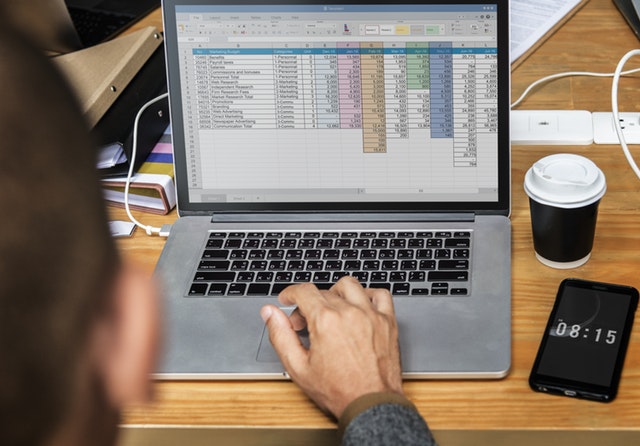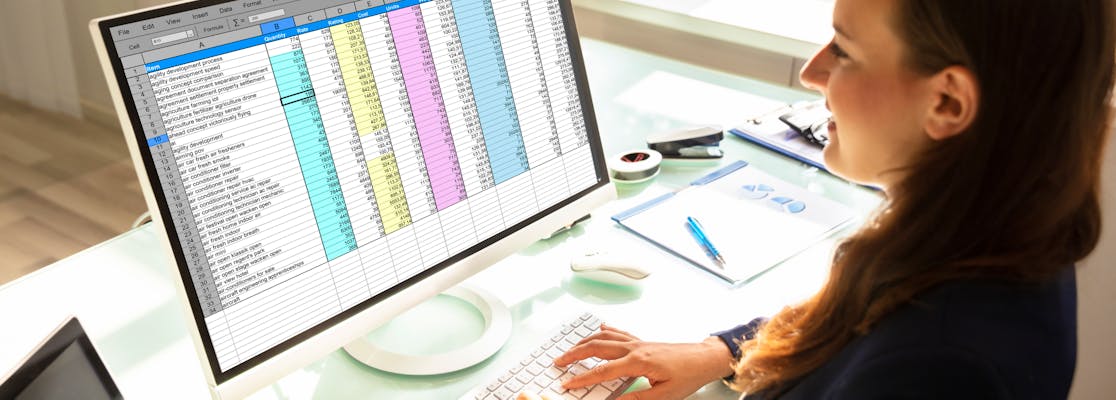Microsoft Excel Tests For Interview (2025 Guide)
All products and services featured are independently selected by WikiJob. When you register or purchase through links on this page, we may earn a commission.
A Microsoft Excel test is a tool that employers use during the recruitment process to check how proficient candidates are with Excel. Spreadsheets allow users to input and analyse data efficiently, and are used in all kinds of office jobs; as such, these tests are becoming increasingly common.
The difficulty of the test varies depending on the position applied for but employers will certainly test candidates’ ability to perform basic functions such as printing, formatting cells and inserting tables.
It is also likely that employers will be looking for an understanding of relative, absolute and mixed references – concepts that are crucial to Excel.
Where candidates are expected to have a more thorough knowledge of Excel they will be asked to demonstrate more advanced functions such as VLOOKUP, SUMIF and COUNTIF, and creating custom charts.
Typical Format of an Excel Test in 2025
The Excel test may be presented as a series of multiple-choice questions or it may use interactive software to simulate the use of Excel’s interface.
Some companies will set a test they have built themselves. This would usually be an interactive test and will often involve working with Excel software itself. In the majority of cases, companies will use specifically designed software from a test provider.
Multiple-choice tests will include questions covering every area of the software, so candidates will need to be very familiar with key functions and layout. The multiple-choice questions are pulled at random from a large pool of possible questions, so no test is the same.
The simulation format is more common for Excel tests. Here candidates must complete a series of tasks on an Excel spreadsheet, according to their skill level.
Candidates will be asked to sit a basic, intermediate or advanced level test, depending on the position they are applying for. We'll cover each in turn.
Get Our Microsoft Excel Practice Test
Basic Excel Test
A basic Excel test is used for positions that require candidates to be comfortable performing the most common Excel tasks. The test may form part of an application for entry-level and administrative jobs.
The types of tasks included in the basic Excel test might include:
- Using basic functions such as SUM, AVERAGE, MIN and COUNT.
- Formatting cells – especially currency formatting, and also borders, shading, alignment, number formatting and wrapping text.
- Creating basic charts.
- Performing simple tasks such as saving a file in more than one format.
Intermediate Excel Test
An intermediate Excel test is used for jobs where candidates will need to work with Excel at a higher level. Along with the skills assessed on the basic test, tasks may include:
- Creating more sophisticated formulas such as IF and LOOKUP.
- Formatting cells – conditional formatting, text columns, adjusting page and print layouts.
- Performing more sophisticated tasks such as using text strings, customising charts and data validation.
Advanced Excel Test
The advanced Excel test is used for jobs where applicants will need to be confident using the full range of Excel’s features and understand how best to apply them.
Candidates for accountancy positions, or other jobs where Excel is used for financial calculations or to manage large databases, may be required to take an advanced Excel skills test. Tasks may include:
- Complex versions of the “IF” and “CONCATENATE” formulas.
- Formatting functions such as locking cells, using group and outline.
- Creating and using PivotTables and PivotCharts.
- Setting up a database.

Excel Test Providers
Many of the psychometric test companies that candidates might be familiar with from previous job application assessments also provide Excel skills test. The most popular are the SHL Microsoft Excel tests and the Kenexa Prove It! Excel tests.
Practice Excel Test with JobTestPrep
SHL Microsoft Excel Tests
SHL provides three different types of Excel skills test: Interactive, Interactive-Essentials and Adaptive. Let's examine each of those:
Interactive Test
This is taken on interactive software that simulates the use of Excel’s interface. Each question consists of a task for the user to complete, along with accompanying data.
There are a maximum of 30 questions with a time limit of around 35 minutes.
Unlike working with Excel for real, the interactive software does not allow much room for trial and error, so formulas and functions must be spelled correctly. Some Excel shortcuts will also be inactive.
Interactive-Essentials Test
This is similar to the Interactive Test above but covers only the most vital and commonly used Excel operations. There are a maximum of 20 questions or tasks with a time limit of about 25 minutes.
Adaptive Test
This Excel skills test uses Computerized Adaptive Testing (CAT), which constantly adapts the test as it progresses according to the examinee’s level.
It's made up of a series of multiple-choice questions of varying difficulty. These are selected based on the candidate’s previous performance on the test.
So if a candidate answers an intermediate level question correctly, the next question will be of the same level or harder, and vice versa.
The Adaptive Test has a maximum of 30 multiple-choice questions and a time limit of 90 minutes, although most candidates will complete it in around 20 minutes.
Kenexa Prove It! Excel Tests
Like the SHL Interactive tests, the Kenexa Prove It! Excel tests are interactive and simulate real Excel software. There are two levels:
- Normal User is a basic Excel test with 30 tasks to complete.
- Power User is an advanced Excel test with 25 tasks.
Usually, the test will include a number of Microsoft Word tests and typing assessments, with Excel among them.
Tasks pop up at the bottom of the screen and candidates must complete each one before moving on to the next. There are no multiple-choice questions.
Again, the Prove It interface does not allow for trial and error in the way that actual Excel software does. Some shortcuts cannot be used and formulas have to be typed out correctly with no help from the programme.
There will only be one correct answer, even if there are a number of ways to perform the action.
Unlike the SHL Excel tests, time is not limited on the Prove It! exams. However, it is measured and will affect the final result.
Sample Questions and Answers for Excel Tests (2025)
Below are a few examples of the types of questions you might see in an Excel skills test. These cover both the interactive and multiple-choice style of test, and there are questions for basic, intermediate and advanced levels.
Sample Interactive Test Questions
Copy the table below into a new Excel spreadsheet, making sure that the cell marked with (A1) is pasted in cell A1 in the spreadsheet. Once the table is in place, move on to the questions below.
Category (A1) | Product Name | Quantity | Inventory | Price per Unit | Total Price |
|---|---|---|---|---|---|
| Office Supplies | Binder | 2 | 20 | 12.99 | 25.98 |
| Office Supplies | Pencil | 20 | 20 | 0.99 | |
| Electronics | Samsung 4K Smart TV | 1 | 5 | 399.00 | |
| Electronics | Bluetooth Speakers | 4 | 5 | 44.49 | |
| Computers | Lenovo X230 12in Laptop | 2 | 2 | 279.90 |
If you need to prepare for a number of different employment tests and want to outsmart the competition, choose a Premium Membership from JobTestPrep.
You will get access to three PrepPacks of your choice, from a database that covers all the major test providers and employers and tailored profession packs.
1. Change the format of the “Total Price” column to “Currency” format.
2. Turn on filtering for the table.
3. Sort the table by column “Category” (A) from A to Z.
Get Our Microsoft Excel Practice Test
1. Under “Total Price”, in cell F3, calculate the total price of the product (Quantity * Price per Unit). Apply the formula to cells F4:F6 as well.
2. Create a Pivot Table for Total Price per Category.
3. In the “Inventory” column (D), use Conditional Formatting to highlight out-of-stock products in red. (Product is out of stock if “Quantity” is greater than or equal to amount in “Inventory”).
1. All Formulas in Excel must start with:
a) # sign
b) @ sign
c) + sign
d) = sign
2. Which of the following actions will “select” all cells in a sheet:
a) Clicking on a column’s letter (e.g. A, B, C…)
b) Selecting the first cell in column A and, while holding Shift, selecting the last cell in column A.
c) Clicking on the space between the first row (marked as number 1) and first column (marked as letter A).
d) Clicking on row number 1.
3. What is the function “Wrap Text” used for?
a) Left-aligning contents of a cell.
b) Center-aligning contents of a cell.
c) Adding a border around a cell.
d) Breaking long content into multiple lines in a cell.
1. Assume you are copying cell A1 to cell C3 as in the picture below. If cell A1 contains the formula =C$1, how would this formula change when copied to cell C3?
a) =EB3+1
c) =E1
d) =1
2. Which of the following formulas has a syntax error / is incorrect:
a) =IFS(A1 = 5, "Excellent", A1 = 4, “Very Good”, “Good”)
b) =IF(A1 = 5, “Excellent”, IF(A1 = 4, “Very Good”, “Good”))
c) =IFS(A1 = 5, "Excellent", A1 = 4, “Very Good”, A1, “Good”)
d) =IF(A1 = 5, “Excellent”, IF(A1 = 4, “Very Good”, IF(A1, “Good”, )))
3. When a cell is cut and pasted into a new cell, what will be pasted in the destination cell?
a) Any content (e.g. text, numbers, formula) of the original cell.
b) Any content (e.g. text, numbers, formula) and formatting of the original cell.
c) Only text or number content of the original cell.
d) Only formatting of the original cell.
e) Only conditional formatting rules of the original cell.
Excel Interview Questions in 2025
Excel is used across many industries and businesses, so employers may ask you questions about Excel during an interview, even if you are not required to perform a skills test.
While this part of the interview may be relatively short (depending on the type of role you are interviewing for and the level of Excel knowledge required), it is still worth considering a few questions you may be asked.
Here are some examples of basic Excel interview questions:
- What is Microsoft Excel?
- What is an Excel cell?
- How do you add more rows or columns to an Excel sheet?
- What is a formula and what is a function?
- What is the VLOOKUP function?
- What is a PivotTable?
- Explain the different kinds of COUNT function Excel offers.
- What types of charts does Excel offer?
The more Excel knowledge the job role requires, the more in-depth the questions will be. An employer will want to see you have a suitable level of Excel knowledge to fit the role requirements.
Tips for Excel Test Preparation and Test-Taking in 2025
You can’t bluff your way through an Excel skills test, so make sure you’re clear about what you will need to know.
Spend some time refreshing your skills and becoming familiar with any features you haven’t used before. Even if you are an experienced Excel user, the pressure of test conditions can affect your performance.
Remember that the interactive tests do not allow for trial and error. Below are a few hints and tips to help you perform at your best:
Step 1. Use online tutorials and practice tests
JobTestPrep has a range of PrepPacks for Excel tests for job interviews, including practice tests and tutorials. Wise Owl Training also has a range of Microsoft Excel tests to try, and Mr Excel is a useful source of advice and information.
Step 2. Practise your timing
Remember that even when time is not limited, it is being measured and will affect your final score. Aim for speed as well as accuracy. Taking practice tests will help you to work quickly and confidently.
Step 3. Do your research
If possible, ask about the test provider and the type of test you will be taking. Then practise accordingly. Assessments often include Word proficiency tests too, so practise these as well.
Step 4. Check where the test will be held
While some companies will ask you to take the test at their offices, online tests taken at home are becoming more popular. In this case, you will receive an email with a link to start the test. Make sure you are somewhere quiet, free of distractions or interruptions.
Excel exams are categorized into basic, intermediate and advanced tests. The difficulty of the Microsoft Excel Exam will depend on the test you have been asked to sit.
The exam you are asked to take will be determined by the job role you have applied for. How hard you find the exam will depend on your Excel ability.
A good score for an Excel test will vary between assessments. Aiming for a minimum score of 70% is a sensible starting point, which should stand you in good stead to progress to the next stage of the application process.
The content of an Excel test will vary according to the position you have applied for. However, you can expect to be tested on basic Excel functions, such as formatting cells, printing and inserting tables.
For job roles that require an advanced understanding of Excel, you will need to show that you can use complex functions, such as VLOOKUP and COUNTIF.
There are three different SHL Microsoft Excel Tests. The SHL Interactive test is a timed assessment, which lasts 35 minutes. The SHL Interactive (Essentials) test is a timed assessment, which lasts 25 minutes. For the SHL Adaptive test, candidates are allowed up to a maximum of 90 minutes.
The SHL Interactive and SHL Interactive (Essentials) Microsoft Excel Tests are both timed assessments. The SHL Adaptive test is not timed, although candidates are allowed a maximum of 90 minutes to complete it.
Although the Kenexa Prove It Excel Tests are not timed, it is still important that you practice time management skills as part of your preparation.
You will also need to refresh your Excel skills and knowledge. Practice using Excel as much as possible, as this will help you to become familiar with the program’s functionality.
You can find many online preparation resources for the Kenexa Prove It Excel Tests, including practice tests and assessments.
Answering a range of different practice questions will help you to identify any areas you need to work on and help you to feel more confident on the day of the test.
Kenexa Prove It Excel Tests are not timed. However, candidates are allowed a maximum of 90 minutes to complete the assessment. Many candidates find that they do not need the whole 90 minutes to complete the Kenexa Prove It Excel Tests.
You can take the Kenexa Prove It Excel Tests as many times as you like. If you are unhappy with your result the first time you take the test, you can sit it again to improve your score.
Kenexa Prove It Excel Tests are scored according to the number of tasks correctly completed within the allotted time frame.





